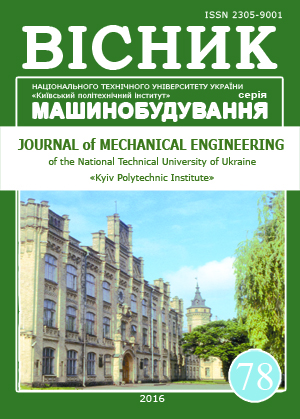DIAGNOSTICS OF ROLLING BEARINGS FOR AUXILIARY ELECTROMOTORS OF ELECTRIC LOCOMOTIVE USING PARAMETRIC MODEL AND ENVELOPE SPECTRUM
DOI:
https://doi.org/10.20535/2305-9001.2016.78.79374Keywords:
autoregressive model, bearing, envelope spectra, fault, motor.Abstract
Goal: increase of efficiency for diagnostics of rolling bearing faults using an autoregressive model to calculate AR coefficients and further application of pre-whitening AR filter and envelope spectra to extract weak faults signs.
Method of doing research: diagnostics of rolling bearing faults involves signal acquisition technique and application of the AR model for better analysis of short duration signal properties and impulses. The Akaike information criterion is used to ensure optimum adaptation of AR coefficients to a fault bearing. The AR coefficients are defined with Yule-Walker equitation. The advantages of pre-whitening AR filter are presented due to the low efficiency regarding the power spectral density of the parametric model. The experimental study of vibration characteristics of the auxiliary electromotor body of electric locomotive defines the frequency band 5,5 — 7 kHz with the rolling bearing vibration, and this frequency band can be used for further extraction the envelope spectra.
Value: the research shows a capability of the pre-whitening AR model to store valuable information not only about different faults concerning outer, inner race, rollers of bearings but also about the technical condition of the cage, the signs of which are displayed on the envelope spectra directly after the AR filter.
References
Javorskyj, I., Kravets, I., Matsko, I. and Yuzefovych, R. (2017), “Periodically correlated random processes: Application in early diagnostics of mechanical systems”, Mechanical Systems and Signal Processing, Vol. 83, pp. 406-438.
Bouraou, N.I., Marchuk, P.I. and Tjapchenko, A.N. (2001), “Analiz sovremennyh metodov obrabotki akusticheskih signalov dlja ih ispol'zovanija v zadachah vibroakusticheskoj diagnostiki”, Akustichnij vіsnik, no 4, pp. 3-10.
Feldman, M.(2011), “Hilbert transform in vibration analysis”, Mechanical Systems and Signal Processing, Vol. 25(3), pp. 735-802.
Сombet, F. and Gelman, L. (2009), “Optimal filtering of gear signals for early damage detection based on the spectral kurtosis”, Mechanical Systems and Signal Processing, Vol. 23(3), pp. 652-668.
Randall, R.B., Randall, R.B., Smith, W.A. and Coats, M.D. (2014), “Bearing diagnostics under widely varying speed conditions”, CMMNO Conference, Lyon, France, pp. 15-21.
Wang, C.Ch. Kang, Y., Shen, P.C., Chang, Y.P. and Chung, Yu.L. (2010), “Applications of fault diagnosis in rotating machinery by using time series analysis with neural network”, Expert Systems with Applications, Vol. 37(2), pp. 1696-1702.
Junsheng, C. and Dejie, Y. (2006), “A fault diagnosis approach for roller bearings based on EMD method and AR model”, Mechanical Systems and Signal Processing, Vol. 20(2), pp. 350-362.
Endo, H. and Randall, R.B. (2007), “Enhancement of autoregressive model based gear tooth fault detection technique by the use of minimum entropy deconvolution filter”, Mechanical Systems and Signal Processing, Vol. 21(2), pp. 906-919.
Wang,W. and Wong, A.K. (2000), A model-based gear diagnostic techniques: Technical Report, Victoria, Australia: DSTO, TR-1079, Airframes and Engine Division, Aeronautical and Maritime Research Laboratory.
Ermishkin, I.A. (2009), “Vspomogatel'nye mashiny”, Lokomotiv, no 6, pp. 34-36.
Tandon, N. and Choudhury, A. (1999), “A review of vibration and acoustic measurement methods for the detection of defects in rolling element bearings”, Tribology International, Vol. 32(8), pp. 469-480.
Tse, P.W., Peng, Y.H. and Yam, R. (2001), “Wavelet analysis and envelope detection for rolling element bearing fault diagnosis - their effectiveness and flexibilities”, Journal of Vibration and Acoustics, Vol. 123(3), pp.303-310.
Balickij, F.Ja., Barkov, A.V. and Barkova, N.A. (2005), Nerazrushajushhij kontrol, Vol. 7, «Mashinostroenie», Moscow, Russia.

